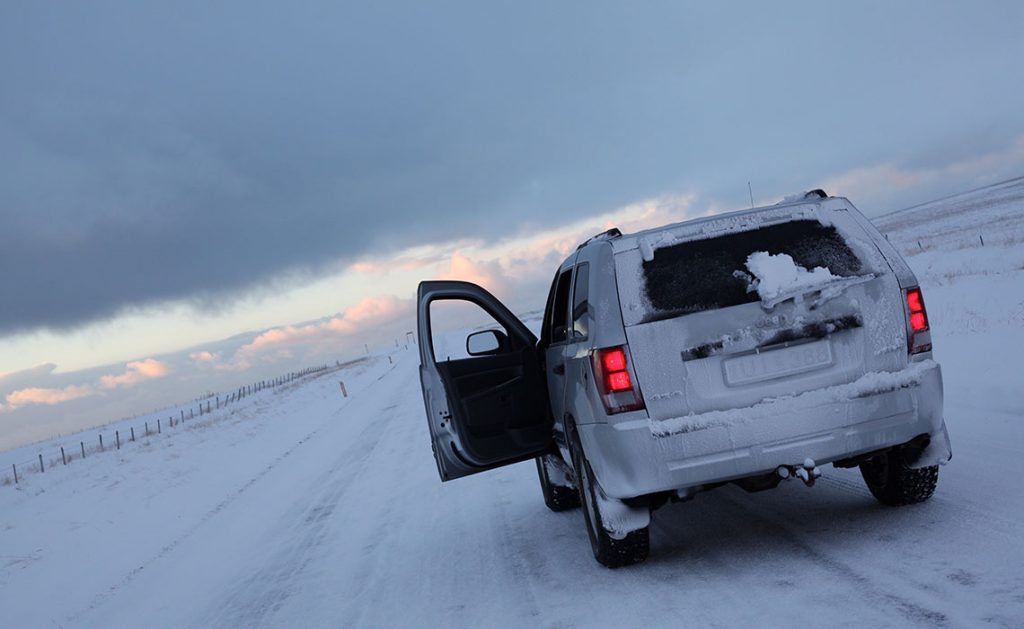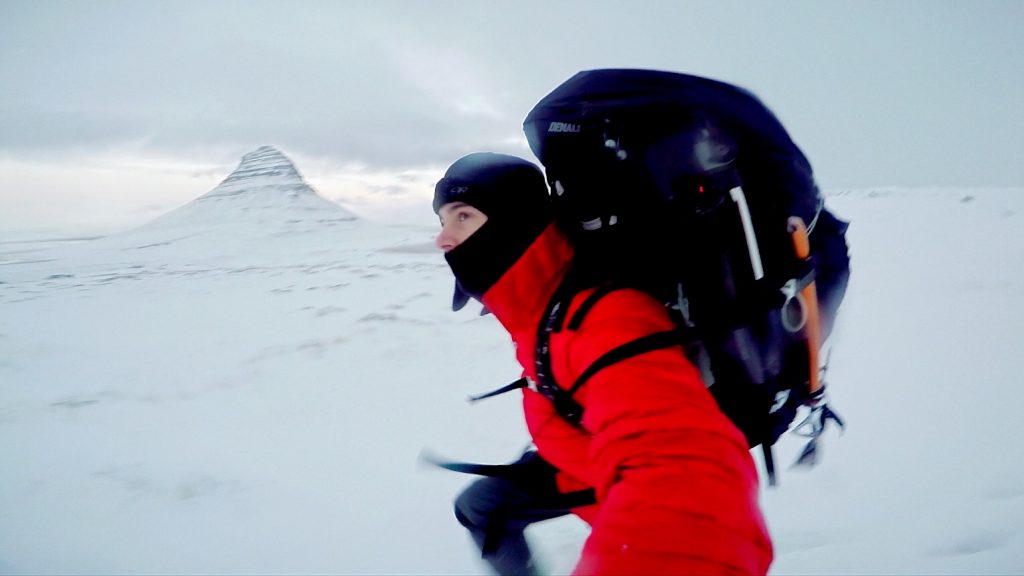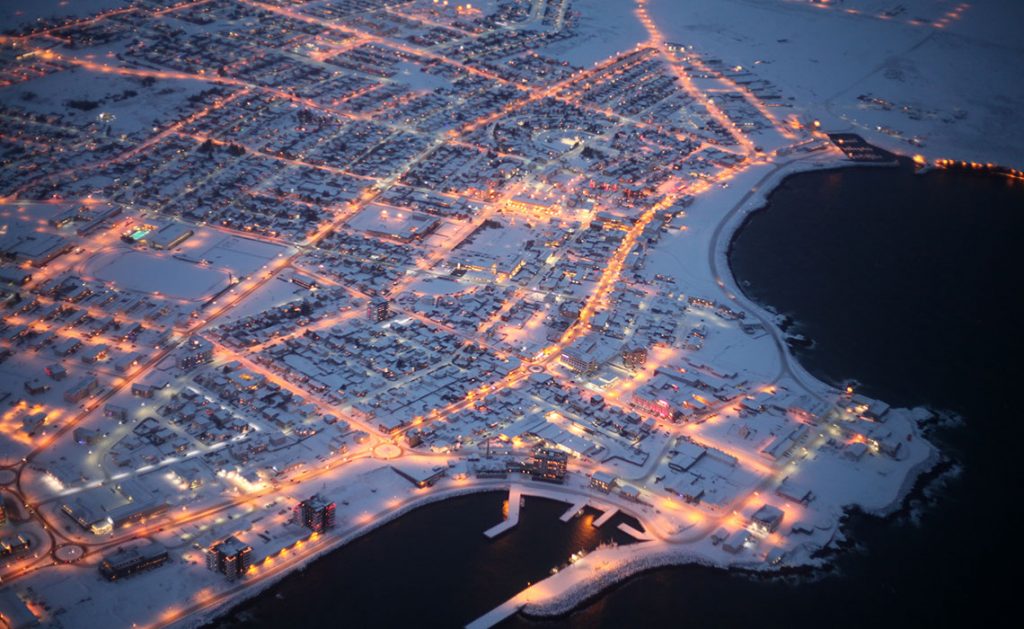I recently had someone ask me about my experience traveling Iceland in wintertime, and after a couple emails, I decided to spin up my thoughts and experiences with that into a blog post.
Going to Iceland at any time of the year should be a no-brainer. Many consider it the New Zealand of the North and Iceland quickly became one of my favorite countries. The place is just breathtaking no matter when you see it, but in winter, it is certainly more unique.
The bummer is only about 5 hours of light. The bonus is better chances of seeing the beautiful Aurora Borealis, better known as The Northern Lights. And the risk, is the weather.
I went to Iceland for a week last December, brought all my winter camping gear, rented a Jeep 4×4, and started driving south out of Reykjavik around 7 am on a Tuesday morning.
Less than an hour into the drive, it was a complete whiteout ice-storm with 50mph winds. Once past the dim city streetlights, it was literally impossible to tell the difference between the road and the surrounding snow blown fields of Southern Iceland. We had to turn around.
Though when I made the move, not being able to see where the road began and ended, the intended three point turn took us right into a snowy ditch and the next hour was spent digging the car out with my ice ax in the middle of the storm before an emergency crew drove by and helped us out. It was quite the way to start the adventure!
We eventually made it back to a hostel in the city and spent the next 24 hours snowbound, walking the town and going to the local geothermal pool. That’s what Icelanders do in winter. They go to the pool. Sometimes twice a day…
The storm on the Southern coast (The Golden Circle) wasn’t letting up, so I shifted plans and we went North, with sights set on the Snæfellsnes Peninsula. Four hours later, we were exploring amazing seaside vistas and setting up camp in the hills just above Kirkjufell mountain.
It was simply stunning and I could not have been happier that the original plan went to shit and a new unexpected one unfolded!

As far as where to sleep when you visit Iceland, farmstays are cool but the best experiences you’ll have will be camping in the countryside. A beautiful thing about the country is that as long as you are not on private property, it is free and acceptable to camp anywhere in the country.
The small print is that you can’t spend more than one night in a single spot, and you can’t have a compound of more than three tents.
“Camping with no more than three tents is allowed on uncultivated ground for a single night, unless the landowner has posted a notice to the contrary. However, campers should always use designated campsites where they do exist. Do not camp close to farms without permission. If a group of more than three tents is involved, these campers must seek permission from the landowner before setting up camp outside marked campsite areas.” – Environmental Agency of Iceland
Of course, going to Iceland in the winter turns camping into its own new beast of a challenge. But if you have the proper gear and are up for the adventure, arctic outdoor camping is the way to go.
It is definitely a more unique experience than car camping and also runs less of a risk of another driver slamming into your parked car as you’re sleeping on the roadside. After our experience going off road, we ended up seeing and helping 4 other cars who slid off throughout the week there.
Recommended Cold Weather Camping Gear:
- -20 Degree F down sleeping bag or warmer (I use the Marmot Colmembrain) on top of the Exped Downmat Winerlite on top of Therm-a-Rest Z Lite Sol. That’s my go-to winter sleep system and I’ve never had a problem sleeping through the night. For extreme cold and an extra layer of protection against the cold ground, you can bring along the Forty Below Insulated Tent Floor. It’s bulky to pack but does make a serious difference.
- I used my Hilleberg Savio tent, which is a 3-person, 4-season arctic and high altitude expedition tent. You can find cheaper winter expedition tents, like the North Face VE-25, but I always recommend what I’ve used and trust 110% with my life. From experience, the Hilleberg Saivo has been simply bombproof, keeping me safe and comfortable in storms dropping over a foot of snow on Mount Rainier, and with winds more than 60mph in Iceland. The material on the Hilleberg is more durable, and it’s much simpler to set up being that the fly and the inner tent are one piece, rather than risk your top tent layer flying away the moment you pull it out of the bag. Of course, the price difference isn’t small, but if you’re venturing into these types of places, think of it as a life insurance investment. The right tent is maybe 60-70% of the battle, and knowledge and technique for keeping warm inside makes up the rest! Check out this post for helpful tips on how to keep your tent warm.
- For clothing, it’s all about layering. Very thin,sweat-wicking liner socks underneath thick warm wool socks. Thin quick dry liner gloves (like the Outdoor Research PL Base Sensor glove) underneath down mittens or bomber expedition gloves. Never wear cotton close to skin, or really even at all. It’s heavy and doesn’t do well with water/snow. A down parka is wonderful for the cold high alpine and tundras, or simply just hanging around your camp or car at night. The Eddie Bauer Peak XV is awesome and currently on sale.
- Gore-tex bib pants are always better than waist-high snow pants. Patagonia and Outdoor Research make solid alpine bibs and you can find others here.
- The best balaclava I’ve ever used.
- Nalgene Wide Mouth Cantene – this will help the gents more than ladies, but when it’s cold and you don’t want to get out of the tent at night to pee, this is great. Super light and packable and you’ll be thankful to have it. Plus (pro-tip!) after use, it acts as a hot water bottle in your sleeping bag. Every bit of warmth counts!
- Forty Below bottle bootie will keep your regular 1-liter Nalgene from freezing. They make great down camp booties too which are nice to wear when hanging at camp or through real cold nights.
- Keep your stuff powered – Venture 30 Solar kit is my go-to! Or, if you need a 110V AC outlet like for powering a MacBook, then upgrade to the Sherpa 100.
- Cooking – I use the MSR XGK stove. It sounds like a jet engine and works all the time, everywhere, with nearly any fuel type (though white gas is best and you can buy this at most gas stations in the city). Also, stormproof matches are a must.
- Safety gear if you’re headed into the backcountry with steep slopes and avalanche danger: BCA Shovel with Snow Saw + BCA Tracker 2 or 3 Beacon with Probe. And actually, the shovel and snow saw are just great pieces to have if you live anywhere that gets snow. Keep those in your car!
- Must reads – Snow Sense (short and easy but packed with info). And the bible for all things outdoors is Freedom of the Hills (huge sections on winter camping techniques and tips).
- If there is any gear you don’t have, need more of, or simply would rather rent than haul there, Iceland Camping Equipment was wonderful to work with. Easy pick up and drop off location, and they even tossed in extra hats, gloves, and mats for free, knowing that the storm was on its way! Good people.
Documenting the Adventure:
My main camera on most adventures is a Canon DSLR, specifically, the EOS 80D. But for Iceland, I rented a Canon EOS 5D Mark ii from Lensrentals.com. That, along with with a 50mm prime lens, an 18-135mm, and a 70-250 telephoto lens, was my setup. Plus a Gorillapod tripod for steady shots and quick setups, and a couple GoPros.
It’s always worth bringing a little extra gear and weight to get the best shot possible. And the single piece that has made all the difference in taking 70% more photos is the Peak Design Capture Camera Clip – you can read the full post about why and my experience with it here.
Helpful Apps for Iceland
The links above are to the Apple Store, but each of these do have Android counterparts. I forget which of the top three had better info for getting around, but they’re all good to have just in case. And the 112 app is the official app for Iceland’s emergency service, so that’s a must have!
Keep this in mind for your winter expedition to Iceland
Expect the unexpected and be ready to roll with the flow. You may not even be able to leave Reykjavik. And if that’s the case, just accept the situation for what it is and have the best damn time you can in the city!
Driving there in the winter is really tricky. With the dim flat light and icy snow covered roads, you’re going to want to make sure your rental car has studded tires and also comes with a GPS to make things a bit safer.
And if you decide to go for it, be prepared for everyone to call you crazy! That’s always half the fun.





I really appreciate the tips here. I am thinking about doing New Years in 2019 in Iceland. I spent two weeks there last August and loved it and want to do it in the winter for a new perspective, and of course to photograph the Aurora Borealis! Did you actually camp at Kirkjufellsfoss?? I have understood the dispersed camping to be a bit of a gray area in Iceland, so much to the point that I avoided it and camped at the official sites…however, that was in peak season, so I might feel a little more brave come winter regarding dispersed camping. Are there any other places you disperse camped??
Thanks!!!
Jim
Glad I could help James! Iceland is just incredible and you’re going to love it in winter! I did camp there for a night, yes. To my knowledge, camping on un-farmed lands (outside of fences) is allowed so long as you are away from roads and waterways, only stay one night in the same place, leave no trace (of course), do not disturb soil/stones/etc., and your camp stove is fine but no ground fires. If you are very close to a farm and have any concern, you could always ask the owner. Odds are they’ll say yes, think you’re crazy, maybe invite you for a meal and drink, and appreciate the heads up. There is a campground in Grundarfjörður, I believe just up beyond the top of Borgarbraut Rd behind the recreation center. That is closed in the winter, meaning no one will be working, but no one will mind if you set up a tent for a night – I’ve asked. That’s kind of the thing with camping in the winter there. No one really does it so whether you’re on public land or a closed campsite, as long as you’re far enough away from road/foot/farm traffic, and are not disturbing people, animals, or land, you likely won’t have anyone come tell you not to!